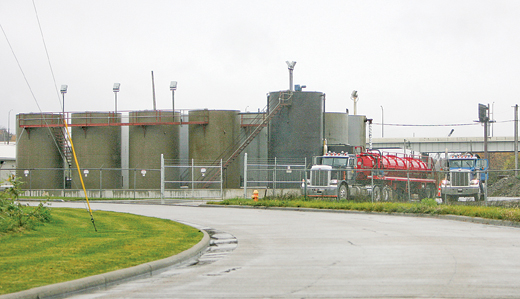Despite quakes, businesses want to drill more wells


Above is the Northstar injection-well site on Ohio Works Drive in Youngstown. The Ohio Department of Natural Resources has 19 applications to drill new disposal wells, and is reviewing the applications under a new set of safety standards, a spokeswoman said.
By Spencer Hunt
Columbus Dispatch
YOUNGSTOWN
The earthquakes that shook Youngstown and drew national attention to “fracking” waste-disposal wells haven’t stopped businesses from wanting to drill more of them in Ohio.
Ohio Department of Natural Resources officials say they have 19 applications to drill new disposal wells. That’s on top of 23 wells already approved but not yet operating.
There are 171 operating disposal wells statewide.
Planned and proposed wells include five in Mahoning County that would be operated by D&L Energy. On March 9, state officials issued a preliminary report that linked the company’s Northstar No. 1 disposal well on Ohio Works Drive to 12 earthquakes that rattled Youngstown late last year.
The agency is reviewing disposal-well applications under a new set of safety standards, said Heidi Hetzel-Evans, a Natural Resources spokeswoman. The standards include a ban on drilling injection wells into a deep, pre-Cambrian rock formation that geologists consider the source of most Ohio quakes.
“Any well moving forward will fall under the new guidelines,” she said.
The review includes D&L’s proposed wells in Mahoning County. Vince Bevacqua, a D&L spokesman, said the wells are “well beyond” a 5-mile radius the state drew around the quake zone.
He said the company’s wells will meet the new state standards. He disputes the state’s preliminary conclusion that injected wastewater from the Northstar No.1 well likely triggered an undetected fault beneath Youngstown.
“It’s still not proven,” Bevacqua said of the well, which has been shut down since Dec. 30.
Ohio’s “class 2” disposal wells operated below the public radar for decades. They take the wastewater, contaminated with salt and heavy metals, that bubbles out of more than 64,400 oil and gas wells in Ohio.
The number of disposal wells began to grow last year with the advent of fracking, the process in which millions of gallons of water, sand and chemicals are injected underground to fracture shale and free trapped oil and gas.
Much of the fluid sent down shale wells comes back up. State records show 53 percent of the 12.2 million barrels of wastewater injected in Ohio disposal wells last year came from Pennsylvania and West Virginia shale wells.
Tom Stewart, vice president of the Ohio Oil and Gas Association, said the growth in disposal wells is a response to drilling companies’ plans to frack Ohio’s Utica shale. The state estimates 2,250 Utica wells will be fracked by 2015.
“These wells will produce water, and they need a place to manage that,” Stewart said.
Since the quakes, environmental advocates have focused on disposal wells as a potential threat to public health and safety.
Gwen Fisher, of Hiram Township in Portage County, said one company’s plans to build four disposal wells in nearby Windham Township worry her. That company, Hard Rock Drilling and Producing, did not return calls seeking comment.
Fisher, a member of a group called Concerned Citizens, Ohio, said she’s worried that poorly constructed wells could leak and contaminate groundwater. “Once an aquifer is contaminated, there is nothing that we can do to fix that,” Fisher said.
State officials argue that there hasn’t been a single incidence of subsurface groundwater contamination since they took over disposal well oversight in 1983.
Stewart used the term “geologic anomaly” to describe the Youngstown quakes.
That doesn’t reassure Susie Beiersdorfer, a part-time Youngstown State University geology professor and a member of a group called Frackfree Mahoning Valley.
Beiersdorfer said she’s concerned that new Mahoning wells might cause more quakes, regardless of the state’s new standards.
“You can’t say for certain that there aren’t faults, even if you don’t drill into the basement [rock,]” she said. “We don’t have the geology well mapped around here. It’s because we’ve never been seismically active.”
 43
43
